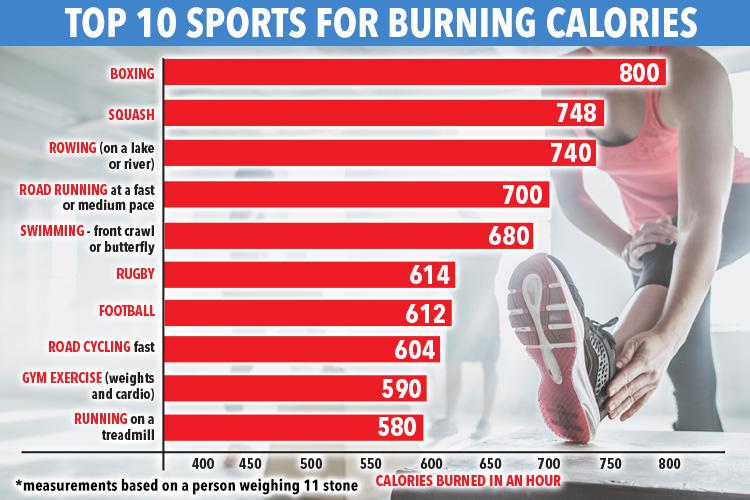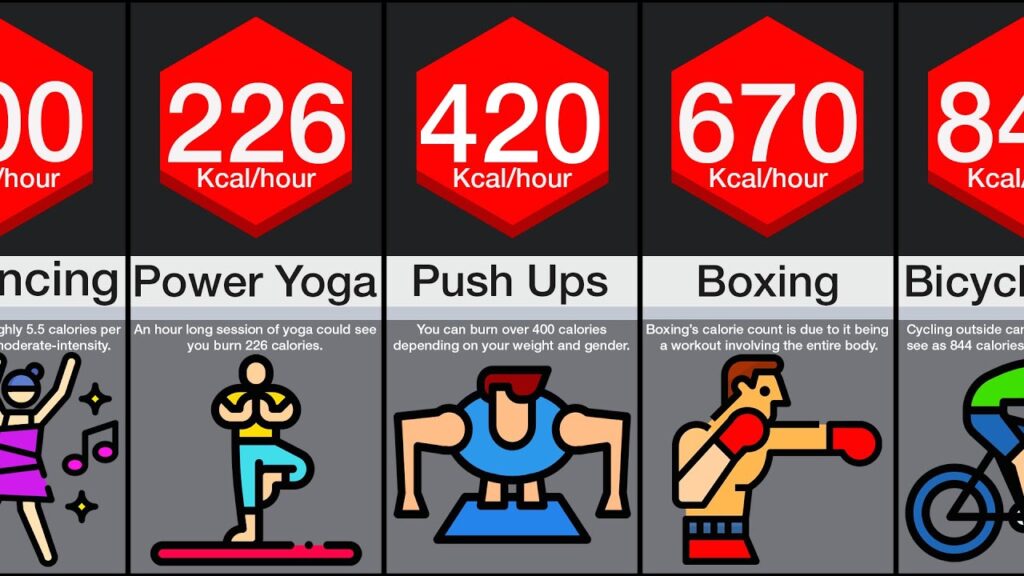
Exercise for Weight Loss: Burning More Calories
Are you looking to shed some pounds and reach your weight loss goals? Look no further than exercise! Exercise is a fantastic way to burn those extra calories and assist with weight loss. Whether you’re going for a brisk walk or cycling your way to better health, cardio exercises are incredibly effective at burning calories and reducing body fat. Strength training, on the other hand, helps you maintain and build muscle, boosting your metabolism and preventing a drop in metabolism during weight loss. Looking for a time-efficient workout? High intensity interval training (HIIT) offers the same weight loss benefits as cardio exercises but in less time. Not only does exercise help with weight management, but it also suppresses appetite and offers a myriad of other health benefits, such as improved blood sugar control and reduced risk of chronic diseases. The Physical Activity Guidelines recommend at least 150 minutes of moderate intensity exercise and 2 resistance training sessions per week for optimal health. While diet remains the most crucial factor in weight loss, exercise certainly plays a vital role in maintaining a healthy weight and overall well-being. So, get moving and start burning those calories!
Table of Contents
ToggleCardio Exercise for Calorie Burning
When it comes to weight loss, one of the most effective types of exercise is cardio exercise. This type of exercise gets your heart rate up and burns a significant number of calories. Some popular forms of cardio exercise include walking, cycling, running, swimming, aerobics, and dancing.
Walking
Walking is an excellent form of cardio exercise. It is low-impact, easy to do, and can be done almost anywhere. Whether you take a leisurely stroll through your neighborhood or power walk on a treadmill, walking can help you burn calories and reduce body fat.
Cycling
Cycling is another great option for cardio exercise. Whether you prefer riding a stationary bike or going on outdoor bike rides, cycling can be a fun and effective way to burn calories. It targets your leg muscles and can also help improve your cardiovascular endurance.
Running
Running is a high-energy cardio exercise that can torch calories in a short amount of time. Not only does it burn calories, but it also helps strengthen your leg muscles and improve your overall fitness level. Whether you prefer running on a treadmill or hitting the pavement outdoors, running is a fantastic option for weight loss.
Swimming
Swimming is a low-impact cardio exercise that can be enjoyed by people of all fitness levels. It is a full-body workout that engages multiple muscle groups, providing an excellent calorie-burning opportunity. Swimming is easy on the joints and can be a refreshing way to cool off while getting a great workout.
Aerobics
Aerobics classes offer a mix of cardiovascular exercises that can help you burn calories and increase your endurance. From high-energy dance workouts to step aerobics, these classes provide a fun and engaging way to get your heart pumping. Many gyms and fitness centers offer a variety of aerobics classes to suit different interests and fitness levels.
Dancing
Dancing is not only a fun and enjoyable activity but also a great way to burn calories. Whether you prefer salsa, hip hop, or ballroom dancing, moving to the rhythm can help you shed unwanted pounds. Dancing engages various muscle groups and improves your balance and coordination, all while providing a cardiovascular workout.
Strength Training for Increased Metabolism
While cardio exercise is essential for calorie burning, strength training is equally important when it comes to weight loss. Strength training helps build and maintain muscle mass, which is crucial for increasing metabolism and preventing a drop in metabolism during weight loss.
Benefits of Strength Training
Strength training offers numerous benefits beyond weight loss. It helps increase bone density, improve joint function, and enhance overall strength and stability. Additionally, building muscle through strength training helps boost your metabolism, allowing you to burn more calories even at rest.
Weightlifting
Weightlifting is one common form of strength training. It involves lifting weights or using resistance machines to target specific muscle groups. Whether you prefer free weights or weight machines, weightlifting can help you build lean muscle mass and increase your overall strength.
Resistance Band Exercises
If you don’t have access to weights or weight machines, resistance band exercises are a convenient and effective alternative. Resistance bands come in various levels of resistance and can be used to target different muscle groups. They are portable and versatile, making them perfect for at-home workouts or when traveling.
Bodyweight Exercises
Bodyweight exercises are an excellent option for strength training, as they require no equipment and can be done anywhere. Exercises like push-ups, squats, lunges, and planks engage multiple muscle groups and can help you build strength and increase muscle tone. Bodyweight exercises are especially beneficial for beginners or those who prefer to exercise at home.
High Intensity Interval Training (HIIT)
High-intensity interval training (HIIT) is a popular form of exercise that offers similar weight loss benefits to cardio exercise but in less time. HIIT involves alternating short bursts of intense exercise with periods of rest or lower intensity exercise.
Explanation of HIIT
During a HIIT workout, you perform short, intense bursts of exercise followed by brief recovery periods. This type of training raises your heart rate and challenges your body in a different way than steady-state cardio exercise. It can be done with various exercises, such as sprinting, jumping jacks, or burpees.
Benefits of HIIT
One of the main benefits of HIIT is the efficiency of the workout. HIIT sessions are typically shorter than traditional cardio workouts but still provide the same, if not greater, calorie-burning benefits. HIIT also helps improve cardiovascular fitness, increases metabolism, and can continue burning calories even after the workout is complete.
HIIT Workouts
There are endless possibilities when it comes to HIIT workouts. You can design your own HIIT routine by combining different exercises, or you can follow structured HIIT workout videos or classes. The key is to push yourself to your maximum effort during the intense intervals and then allow yourself to recover during the rest periods.
Tabata Training
Tabata training is a specific type of HIIT workout that follows a 20-seconds-on, 10-seconds-off format. It was named after Dr. Izumi Tabata, a Japanese researcher who studied its effects on athletes. Tabata training typically involves eight rounds of 20-second high-intensity intervals followed by 10 seconds of rest. It is a highly effective way to boost your metabolism and burn calories.
The Role of Exercise in Appetite Suppression
In addition to its calorie-burning benefits, exercise can also help suppress appetite, making it easier to manage your weight.
How Exercise Suppresses Appetite
Exercise affects appetite by regulating hormones that control hunger and fullness. When you exercise, your body releases hormones that suppress appetite, such as peptide YY (PYY) and glucagon-like peptide-1 (GLP-1). These hormones send signals to your brain, telling it that you are full and reducing your desire to eat.
Effects on Hunger Hormones
Exercise can also influence the levels of hunger hormones in your body. It decreases the production of ghrelin, a hormone that stimulates appetite, while increasing levels of peptide YY and GLP-1. This hormonal balance can help reduce cravings and prevent overeating.
Exercise and Weight Management
Regular exercise not only helps with weight loss but also plays a crucial role in weight management. By suppressing appetite and regulating hunger hormones, exercise can support healthy eating habits and prevent weight regain. Incorporating both cardio exercise and strength training into your routine can help you achieve and maintain your weight loss goals.
Other Health Benefits of Exercise
Beyond weight loss and appetite suppression, exercise offers a wide array of other health benefits. Incorporating regular physical activity into your lifestyle can have a positive impact on multiple aspects of your well-being.
Improved Blood Sugar Control
Exercise plays a significant role in improving blood sugar control, making it beneficial for individuals with diabetes or at risk of developing diabetes. Physical activity helps your body better utilize insulin, which helps regulate blood sugar levels. Regular exercise can reduce insulin resistance and lower the risk of type 2 diabetes.
Reduced Risk of Chronic Diseases
Engaging in regular exercise can help reduce the risk of chronic diseases, such as heart disease, stroke, and certain types of cancer. Physical activity improves cardiovascular health, strengthens the immune system, and enhances overall body function. It also helps maintain a healthy weight, which is crucial for preventing chronic diseases.
Increased Energy Levels
Exercise has been shown to increase energy levels and combat fatigue. Regular physical activity improves your body’s ability to deliver oxygen and nutrients to your muscles, enhancing your endurance and reducing feelings of tiredness. Even a short walk or a quick workout can boost your energy levels and improve your productivity throughout the day.
Improved Sleep Quality
Exercise can have a positive impact on sleep quality. Regular physical activity promotes better sleep by reducing insomnia and improving sleep duration. It helps regulate your circadian rhythm, increases deep sleep, and reduces stress and anxiety, all of which contribute to better sleep quality.
Boosted Mood and Mental Well-being
Physical activity is closely linked to mental well-being and can significantly boost your mood. Exercise stimulates the production of endorphins, which are natural mood elevators. It also reduces stress, anxiety, and symptoms of depression. Incorporating exercise into your daily routine can help you feel happier, more relaxed, and better able to cope with stress.
Physical Activity Guidelines for Weight Loss
To reap the maximum health benefits of exercise, it is essential to follow the recommended physical activity guidelines.
Recommended Exercise Duration
The Physical Activity Guidelines for Americans recommend that adults engage in at least 150 minutes of moderate-intensity aerobic activity or 75 minutes of vigorous-intensity aerobic activity per week. These guidelines can help you maintain a healthy weight and improve your overall fitness level.
Moderate Intensity Exercise
Moderate-intensity exercises include brisk walking, cycling, and swimming. During these activities, you should be able to talk, but not sing, comfortably. Aim for 30 minutes of moderate-intensity exercise on most days of the week to meet the recommended guidelines.
Resistance Training
The guidelines also recommend performing resistance training exercises at least two days a week. This can include weightlifting, resistance band exercises, bodyweight exercises, or using weight machines at the gym. Resistance training helps build and maintain muscle mass, promoting a healthy metabolism and overall strength.
Finding the Right Exercise Routine
Finding the right exercise routine is crucial for long-term success and adherence. Choose activities you enjoy and that fit into your lifestyle, whether it’s walking, swimming, dancing, or attending fitness classes. Consistency is key, so aim for a routine that is sustainable and enjoyable for you.
The Importance of Diet in Weight Loss
While exercise is essential for weight loss and overall health, it is crucial to remember that diet plays the most significant role in weight management.
Calorie Deficit
To lose weight, you must create a calorie deficit, which means consuming fewer calories than you burn. Exercise can help create this deficit by burning additional calories, but it is equally important to pay attention to your calorie intake and make healthy food choices.
Healthy Eating Habits
Adopting healthy eating habits is essential for weight loss and overall well-being. Focus on consuming a wide variety of fruits, vegetables, whole grains, lean proteins, and healthy fats. Avoid processed foods, sugary beverages, and excessive amounts of saturated fats and added sugars.
Nutritional Balance
To support your weight loss goals, strive for a balanced and nutritious diet. Ensure you are getting adequate amounts of essential nutrients, such as vitamins, minerals, and fiber. Plan your meals with a balance of carbohydrates, proteins, and fats to provide sustained energy and promote satiety.
Weight Loss Plateaus
It is common to experience weight loss plateaus, where your progress slows down or stalls. Incorporating regular exercise into your routine can help overcome weight loss plateaus by adding an additional calorie burn and keeping your metabolism active. However, it may also be necessary to reevaluate your diet and make adjustments to continue progressing towards your goals.
Combining Diet and Exercise
The most successful approach to weight loss and weight management is to combine a healthy diet with regular exercise. The synergy between the two can optimize results and improve both physical and mental well-being. Remember, sustainable weight loss requires long-term lifestyle changes rather than relying on short-term diet or exercise plans.
Using Exercise to Maintain Weight Loss
Once you have achieved your weight loss goals, it is important to use exercise as a tool for weight maintenance.
Importance of Exercise in Weight Maintenance
Regular exercise plays a crucial role in weight maintenance by preventing weight regain. It helps preserve lean muscle mass, which is important for maintaining a healthy metabolism. Exercise also provides a psychological boost and helps manage stress, reducing the likelihood of emotional eating.
Calorie Monitoring
To maintain your weight, it is essential to monitor your calorie intake and expenditure. While you may not need to be in a calorie deficit for weight maintenance, it is still important to be aware of the calories you consume and ensure you are not consuming more than you burn. Tracking your food intake and exercise can be helpful in this regard.
Combining Cardio and Strength Training
To maintain weight loss and overall fitness, it is beneficial to continue incorporating both cardio and strength training into your exercise routine. Cardio exercise helps burn calories and maintain cardiovascular health, while strength training maintains muscle mass and prevents a decrease in metabolism.
Incorporating Various Types of Exercise
Variety is key to keeping exercise enjoyable and maintaining a consistent routine. Incorporate various types of exercise into your schedule, such as different cardio activities, resistance training, yoga, or recreational sports. Mixing up your workouts not only prevents boredom but also challenges your body in different ways.
Setting Realistic Goals
When it comes to weight maintenance, it is important to set realistic and sustainable goals. Aim to maintain your weight within a range that you are comfortable with, rather than striving for an unrealistic or unsustainable weight. Focus on how exercise makes you feel and the overall improvements in your health and well-being.
Exercise for Overall Health and Well-being
Exercise offers numerous long-term health benefits beyond weight loss and weight management. Regular physical activity has a positive impact on your overall health and well-being.
Long-Term Health Benefits
Engaging in regular exercise can extend your lifespan and improve your overall quality of life. It helps prevent chronic diseases, such as heart disease, stroke, diabetes, and certain types of cancer. Regular physical activity strengthens your immune system, improves cardiovascular health, and enhances organ function.
Reduced Risk of Conditions
Exercise plays a significant role in reducing the risk of certain conditions and health issues. It can help lower blood pressure, improve cholesterol levels, and reduce the risk of osteoporosis. Physical activity also contributes to better mental health and can reduce the risk of depression, anxiety, and cognitive decline.
Improved Physical Fitness
Regular exercise improves physical fitness in various ways. It increases endurance, strength, and flexibility, making everyday activities easier to perform. Physical fitness also enhances sports performance and reduces the risk of injuries.
Enhanced Cognitive Function
Exercise has been shown to improve cognitive function and brain health. It enhances memory and learning abilities, boosts creativity, and improves focus and concentration. Physical activity increases blood flow to the brain, promotes the growth of new brain cells, and triggers the release of chemicals that support brain health.
Stress Reduction
Exercise is a natural stress reliever and can help reduce feelings of anxiety and stress. Physical activity triggers the release of endorphins, which are natural mood elevators, and helps regulate stress hormones in the body. Engaging in regular exercise can provide a sense of relaxation, improve sleep, and enhance overall mental well-being.
Conclusion
Exercise is a powerful tool for weight loss, weight management, and overall health. Cardio exercise, strength training, HIIT, and other forms of physical activity offer numerous benefits that extend beyond calorie burning. When combined with a healthy diet, exercise allows for sustained weight loss, improved overall fitness, reduced risk of chronic diseases, enhanced cognitive function, and increased well-being. Remember to find activities you enjoy, set realistic goals, and prioritize a balanced lifestyle that incorporates regular exercise.
Discover how exercise can help with weight loss by burning calories. Cardio exercises like walking, cycling, and running are effective, while strength training boosts metabolism. HIIT offers efficient workouts. Exercise also suppresses appetite and has other health benefits. Find out the recommended exercise guidelines for optimal weight management. Remember, diet is crucial too!





